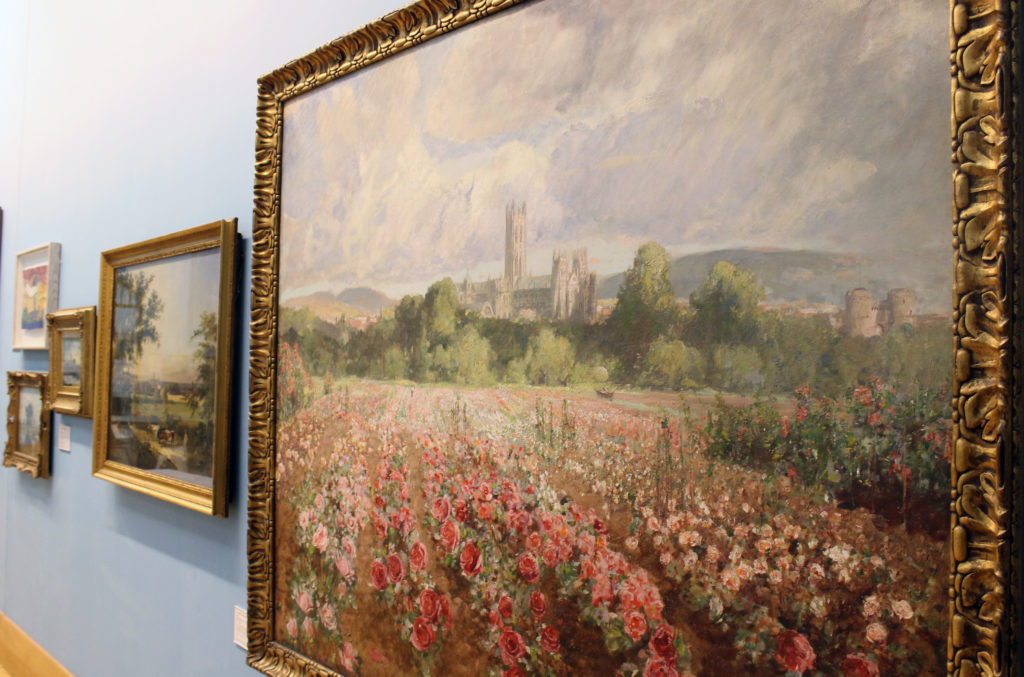
Easter fun at the museums!
Exhibitions, trails and activities; six fun things for all the family to enjoy at The Beaney and...
Today I am drawn to the display of dolls houses and furniture in the Materials and Masters room. The bottom shelf of the cabinet is packed with household items, a bric-a-brac array of plates, serving dishes, cups, glasses, jugs, pots and pans and even butter presses. With its muddle of period items – Toby jugs, neo-classical amphora, painted plate and printed tobacco tin – it’s a diminutive flea market, a junk shop warehouse. But this is the world below stairs. The shelf above is all calm, order and middle-class serenity. Or is it?
While I study these scenes, a small girl and her father play with the toy dolls’ house in the centre of the room. The father tells the dolls a story as the girl tucks them into their beds. Bye bye says the girl when play is over, closing the front of the house. All sleeping. Before they leave the father opens a side window and they peer in, checking that all is still.
Do they think they may catch the dolls carrying on without them, getting out of bed and switching on the lights, breaking the rules of play?
What if these little figures, made in our own image, continued their lives when we weren’t looking?
Such thoughts are the stuff of numerous narratives, the essence of Toy Story, of dystopic automata tales (The Sandman, Pygmalion, Metropolis), of horror movies inhabited by blank-faced Victorian dolls and self-animated puppets. But when we stop acting like Olympian gods, working our ideas and frustrations out on malleable others, and let the dolls get on with it, we begin to treat the figures of play like characters in fictions. Just as children invest stuffed bears and Barbie dolls with complex personalities and private narrative worlds, so writers create their own protagonists and settings. And when a writer is in the thick of a story and forced to lay it aside, when a reader deep in a novel must put the book away, a subtle fear creeps in. It feels as if those characters are carrying on without us. We must get back to the story quickly, in case we miss anything.
If this is true, then when we open the door of the dolls’ house we could be interrupting something. We could be happening upon another story, and glimpsing a narrative we have had no hand in creating.
Look carefully at those shelves in the dolls’ house display. Above the clutter of pewter and pottery is the world of the drawing room. This is a space for quiet leisure. A man reclines on the chaise longue, resting after a day’s work. At his feet, a rack of newspapers. A harp, baby grand and lute for this evening’s entertainment. A sewing machine and typewriter for discreet, creative industry. There are rich rugs on the floor, fine dressers, books, comfortable chairs, even a camera to capture family gatherings. It’s grand, but cosy. There are signs of wealth, of travel. Look closer. Anything make you feel uncomfortable? That birdcage looks like a pagoda. Are those figures on the mantelpiece an echo of slavery? The bear rug is still showing its teeth. That carved elephant looks like ivory. Somebody must have shot a stag to get those antlers.
Look at the man. Is he resting peacefully, or is he troubled? He has flopped onto the couch in a state of exhaustion. He is still wearing his shoes and clutching his hat. He hasn’t unbuttoned his jacket. No one has greeted him and taken his things. He stares at the ceiling in dismay, or disbelief. Or is he waiting for the analyst to come, so he can pour out the anxieties and guilt that are the price of his bourgeois lifestyle? There are two books on the floor in the far corner. Either he hasn’t noticed, or he threw them there.
Upstairs, the dining room table is set for a meal. There are six chairs, though only four places have been laid. But the sideboard door is open – perhaps the maid has been called away before she could finish. Perhaps the housekeeper has just heard that there will be guests this evening, and two extra chairs have been brought in. Certainly, whatever scene was playing out, it was interrupted. That carpet sweeper needs to go back in the scullery for a start. And the dustpan and brush. If you peer into the room with your eyes at floor level, you’ll spot the dropped glassware. What was so urgent that it hasn’t been picked up? What news was devastating enough to cause this accident and then abandon it? Are the glasses somehow connected to those discarded books?
While the lady of the house rests her feet on a stool, the nurse tucks baby into the cradle and the outdoor staff see to watering the plants, a veiled woman leans drunkenly in the kitchen, swooning away from the heat of the stove. Two bridesmaids stand to attention in the parlour, their tea untouched. Upstairs, the young mistress sits in the bath. With her shoes on.
Madness? Murder? Impending suicide?
Something terrible is playing out in this domestic idyll.
No wonder the master has collapsed onto that couch.
